Instructions for Side by Side Printing
- Print the notecards
- Fold each page in half along the solid vertical line
- Cut out the notecards by cutting along each horizontal dotted line
- Optional: Glue, tape or staple the ends of each notecard together
Exam 1
front 1 The first genetic material on Earth was most likely | back 1 RNA |
front 2 Which organism appeared first on Earth? | back 2 bacteria |
front 3 Plant spores are | back 3 haploid |
front 4 Moss is a | back 4 nonvascular plant |
front 5 In seedless vascular plants which generation is dominant? | back 5 sporophyte |
front 6 In angiosperms the, ___________ becomes the fruit | back 6 ovary |
front 7 Ferns first appeared approximately | back 7 475 mya |
front 8 Flowering plants first appeared approximately | back 8 125 mya |
front 9 The photosynthetic cells of a plant are | back 9 parenchyma |
front 10 In plants, spores are formed by | back 10 meiosis |
front 11 That new flu strain is H7N9. The N gene is a gene that | back 11 Helps the virus get OUT of the host cell |
front 12 Area A has a water potential of 0.23 MPa. Area B has a water potential of 0.32MPa. Where will water be going? | back 12 From area A to area B |
front 13 The FIRST plant group to have pollen was the | back 13 gymnosperms |
front 14 What is the correct sequence of events in the origin of life? | back 14 Synthesis of organic monomers, synthesis of organic polymers, formation of protobionts, formation of DNA-based genetic systems |
front 15 Fossilized stromatolites | back 15 Resemble structures formed by bacterial communities that are found today in some warm, shallow salty bays |
front 16 At approximately what time in Earth's history did oxygen become abundant in the atmosphere for the first time? | back 16 2.3 billion years ago |
front 17 Which of the following was not a challenge for survival for the first land plants? | back 17 Animal predation |
front 18 Which of the following is true for the life cycle of mosses | back 18 Antheridia and Archegonia are produced by gametophytes |
front 19 Spores develop into | back 19 gametophytes |
front 20 Gametophytes make | back 20 gametes |
front 21 In which of the following taxa does the mature sporophyte depend completely on the gametophyte for nutrition? | back 21 Bryophyta |
front 22 A botanist discovers a new species of plant in a tropical rain forest. After observing its anatomy and life cycle, he notes the following characteristics: flagellated sperm, xylem with tracheids, separate gametophyte and sporophyte generations with the sporophyte dominant, and no seeds. The plant is probably most closely related to | back 22 Ferns |
front 23 Evidence indicates that plants increase the number of stomata in their leaves as atmospheric CO2 levels decline. Increasing the number of stomata per unit surface area should have the effect of doing which of the following? | back 23 increasing dehydration of leaf tissues, countering the effect of declining CO2 on photosynthesis, increasing the O2 content of air next to the leaves higher than it would be otherwise |
front 24 In addition to seeds, which of the following characteristics are unique to the seed-producing plants? | back 24 pollen |
front 25 Which of the following can be found in gymnopsperms? | back 25 pollen |
front 26 Angiosperm double fertilization is so-called because it features the formation of | back 26 one embryo involving one sperm cell and an endosperm involving a second sperm cell |
front 27 Which of the following are structures of angiosperm gametophytes? | back 27 pollen |
front 28 How have fruits contributed to the success of angiosperms? | back 28 by facilitating dispersal of seeds |
front 29 Which of the following flower parts develop into a seed? | back 29 ovule |
front 30 Which of the following would Professor Stevens consider a seedless vascular plant? | back 30 fern |
front 31 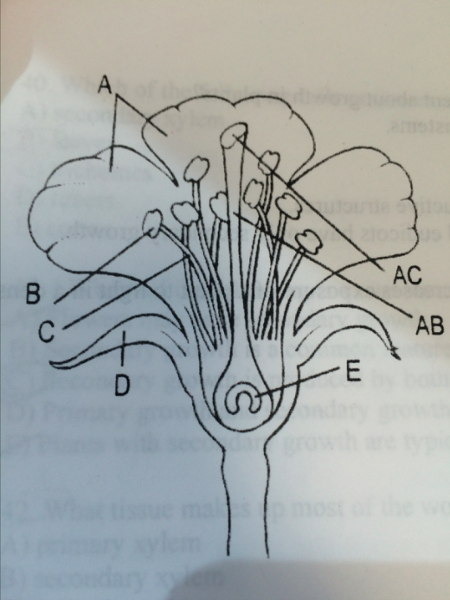 On the picture, D is the | back 31 sepal |
front 32 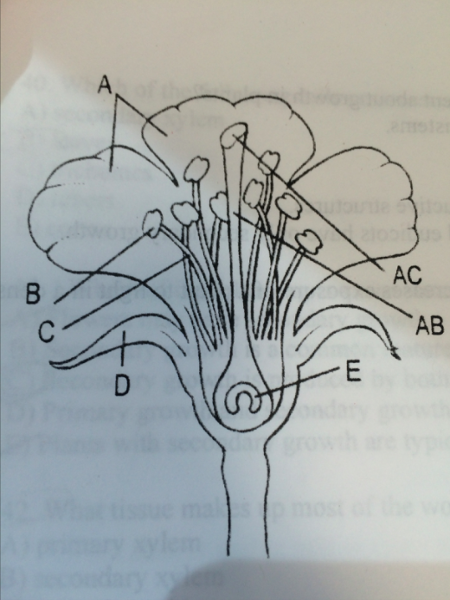 B is the | back 32 anther |
front 33 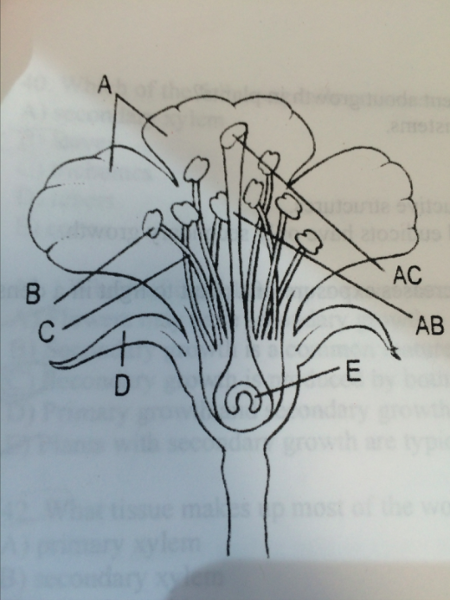 AC is the | back 33 stigma |
front 34 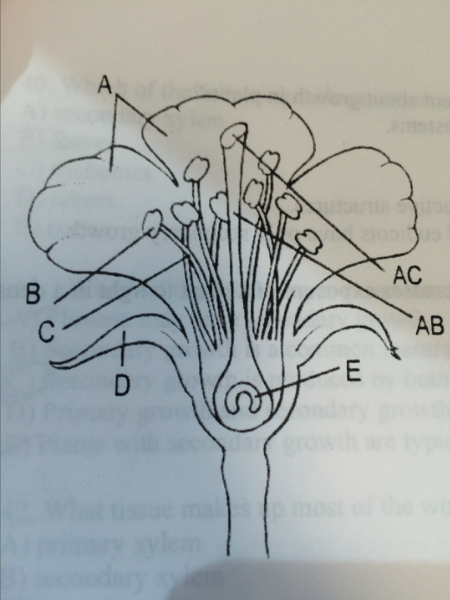 AC and AB are part of the | back 34 carpel |
front 35 Plants contain meristems whose major function is to | back 35 produce more cells |
front 36 Which of the following is a true statement about growth in plants? | back 36 some plants lack secondary growth |
front 37 What would be a plant adaption that increases exposure of a plant to light in a dense forest? | back 37 apical dominance |
front 38 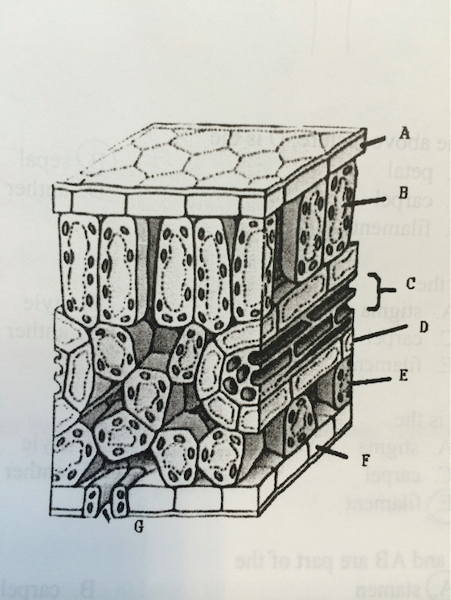 In the above diagram C is the | back 38 vascular bundle |
front 39 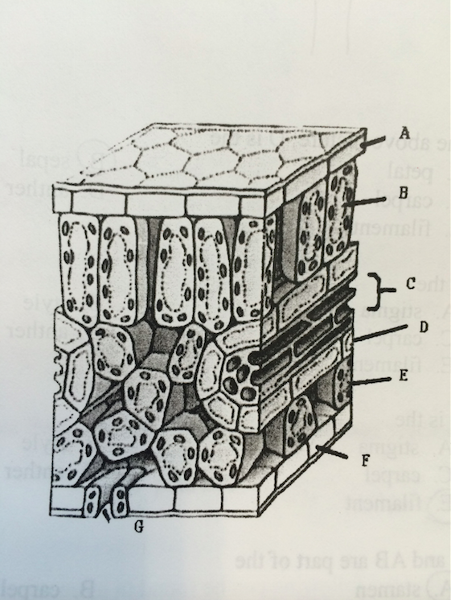 F is the | back 39 epidermis |
front 40 Which of the following cells or tissues arise from lateral meristem activity? | back 40 secondary xylem |
front 41 Which of the following is a true statement? | back 41 Secondary growth is produced by both the vascular cambium and the cork cambium |
front 42 What tissue makes up most of the wood of a tree? | back 42 secondary xylem |
front 43 If you drive a nail in the trunk of a young tree that is 3 meters tall, and the nail is about 1.5 meters from the ground, how many meters above the ground is the nail fifty years later? | back 43 1.5m |
front 44 An open beaker of pure water has a potential of | back 44 0.0 |
front 45 The value for potential in root tissue was found to be -0.15MPa. If you take the root tissue and place it in a 0.1M solution of sucrose (potential=-0.23MPa), the net water flow would | back 45 be from the tissue into the sucrose solution |
front 46 Compared to a cell with few aquaporins in its membrane, a cell containing many aquaporins will | back 46 have a faster rate of osmosis |
front 47 What drives the flow of water through the xylem? | back 47 the evaporation of water from the leaves |
front 48 What is the main force by which most of the water within xylem vessels moves toward the top of a tree? | back 48 evaporation of water through stoma |
front 49 What is responsible for the cohesion of water molecules? | back 49 hydrogen bonds between the oxygen atom of one water molecule and a hydrogen atom of another water molecule |
front 50 An outer and an inner phospholipid bilayer is a characteristic of | back 50 gram negative bacteria |
front 51 Bacterial chromosomes are | back 51 circular |
front 52 Bacteria can survive long periods of stress by forming | back 52 endospores |
front 53 Approximately 8-9% of your DNA is | back 53 virus DNA |
front 54 On the diagram, the group circled, which includes species B and species C, wold be | back 54 monophyletic |
front 55 On the diagram, if I made a group of species A,B,C, and D, it would be | back 55 monophyletic |
front 56 Professor Stevens is a member of Phylum Chordata. If I wanted to know more about him, the next more specific category in the old fashioned Linnaean system would be... | back 56 Class |
front 57 The scientific name of the red salamander is Pseudotriton ruber. Pseudotrition is the organsim's | back 57 Genus |
front 58 This is when bacteria take in foreign DNA | back 58 transformation |
front 59 For bacteria to share genes with other bacteria, they need the | back 59 F plasmid |
front 60 To open a stomata, a cell will | back 60 pump K into the cell |
front 61 When a guard cell is __________, the stomata will open | back 61 turgid |
front 62 These organisms invented photosynthesis | back 62 bacteria |
front 63 The organism that causes Toxoplasmosis is a(n) | back 63 protozoan |
front 64 The most recent ancestor of animals is the | back 64 protozoans |